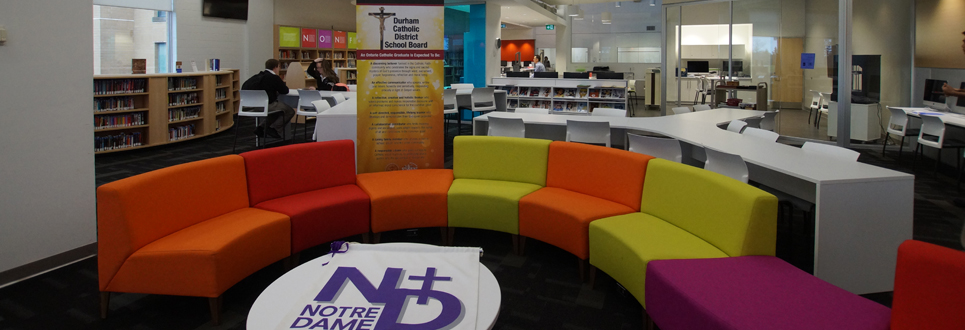
Durham Catholic District School Board is committed to supporting students to live, learn and contribute ethically in the 21st Century. It is our goal to provide students with the tools, skills, and knowledge they require to flourish in an ever-evolving world.
Learning Commons in DCDSB Schools
A Learning Commons (formerly known as the school library) is a flexible and responsive approach to helping schools focus on learning collaboratively. It expands the learning experience, taking students and educators into virtual spaces beyond the walls of a school. Students need to learn transferable skills in order to work efficiently and successfully in our world. To achieve this, students will need to become critical consumers of information, effective problem solvers, capable decision makers and innovative communicators. They will require the skills and ability to flow with change. More importantly, students will need to understand that these transferable skills give them the capacity as an individual to make a difference in their world.

Learning Commons continue to be a place for students to find resources. Resource collections are constantly being reviewed and reorganized in our schools to promote and reflect best practices, including culturally relevant and responsive pedagogy.
LaunchPad Learning Portal
DCDSB is committed to providing 21st century learning skills. Our learning portal, LaunchPad, offers students access to board and ministry approved digital resources anywhere and anytime!
LaunchPad provides access to:
- Edsby;
- Microsoft 365 Suite;
- Blended Learning and e-Learning/online learning courses; and
- Much more, including resources for research, math, coding and French.
Online Learning
The Ministry of Education requires secondary students to earn two eLearning credits as part of the requirements to graduate with an Ontario Secondary School Diploma (OSSD). Students can earn these credits through our board's e-Learning program.
Courses meet all curriculum expectations and standards and are taught by qualified teachers. Efforts are made to ensure students have access to courses from Catholic school boards across the province.
An e-Learning course is conducted entirely online using the Ontario Learning Management System (LMS) and other school board tools. Taking an e-Learning course gives students more flexibility in their timetable and opportunities to earn credits while building valuable independent learning skills that will be beneficial to any post-secondary pathway. Taking an eLearning course/credit allows students to access courses that may not be available at their home school and provides students with the opportunity to gain valuable life-long learning skills.
Success in e-Learning courses requires students to be independent and self-motivated learners.
Coding, Innovation & STEM
Visit our webpage for more information about Coding, Innovation & STEM at DCDSB.
